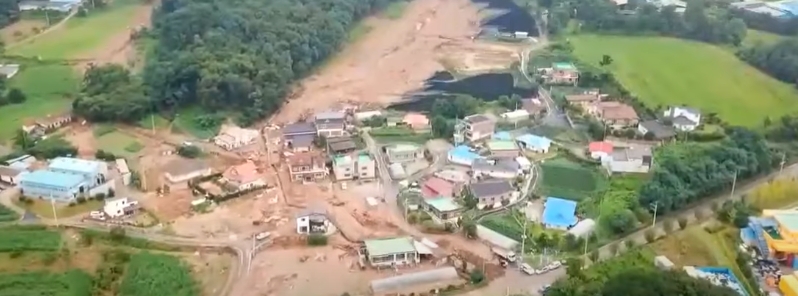Longest monsoon in 33 years batters Korean Peninsula, leaving scores dead and 7 000 homeless

Flooding and landslides due to prolonged monsoon continue to wreak havoc across the Korean Peninsula, prompting almost 7 000 people to evacuate and leaving at least 42 dead or missing in the South as of August 9, 2020. The rainy season has been lashing the country for 50 days as of August 12, making this season the longest monsoon since 1987. Meanwhile, the extent of damage is not precisely identified in the North, but local media reported that wide swaths of crops have been lost and almost 1 000 houses have been damaged or destroyed.
In South Korea, the government confirmed at least 30 fatalities and eight injured while 12 others remain missing after flooding and landslides struck.
Almost 7 000 had also been evacuated as of Sunday, August 9, according to Yonhap news agency. Some 4 600 of them remain at temporary shelters following warnings of further disasters.
About 9 300 ha (22 980 acres) of farmland were inundated, while 9 500 public and private facilities have been damaged.
At the Seomjin River in the peninsula's southern edge, about 100 m (328 feet) of levee collapsed due to heavy rains. Some 1 900 people evacuated in the province, including around 500 people near the river.
The forestry agency has elevated landslide warnings to its highest level in every region, except Jeju Island.
Last week, five houses were buried in a landslide from a mountain behind a village in Gokseon. Five people died, while three others were rescued.
South Korea's annual monsoon season has continued for 50 days as of August 12, marking its longest monsoon season since 1987.
According to the Korea Meteorological Administration, heavy rains will continue in Seoul, Gyeonggi, and western Gangwon until August 16.
In North Korea, floodgates of a dam near the border with South remain partially open amid heavy downpours, the Joint Chiefs of Staff said Tuesday, August 11.
"Our assessment is that the floodgates of Hwanggang Dam are partially open due to heavy rains in the North Korean region," said spokesperson Col. Kim Jun Rak.
While the extent of damage due to rains is not precisely determined, state media said North Korean leader Kim Jong Un visited flood-hit areas. In North Hwanghae, about 600 ha (1 500 acres) of rice fields were destroyed, while almost 1 000 homes were inundated.
"The government is keeping a close eye on the torrential rainfall situation near the inter-Korean border areas while taking necessary measures for the safety of our people, including evacuating residents beforehand and sharing information with other agencies," the official added.
North Korea’s Red Cross has mobilized 43 000 volunteers who have been working alongside health teams and authorities to prevent COVID-19.
The team has also been "helping communities to be prepared to evacuate and reduce disaster risks in their areas, including protecting homes from flooding and landslides," said the International Federation of Red Cross and Red Crescent Societies.
Featured image credit: ARIRANG NEWS/YouTube

Commenting rules and guidelines
We value the thoughts and opinions of our readers and welcome healthy discussions on our website. In order to maintain a respectful and positive community, we ask that all commenters follow these rules.